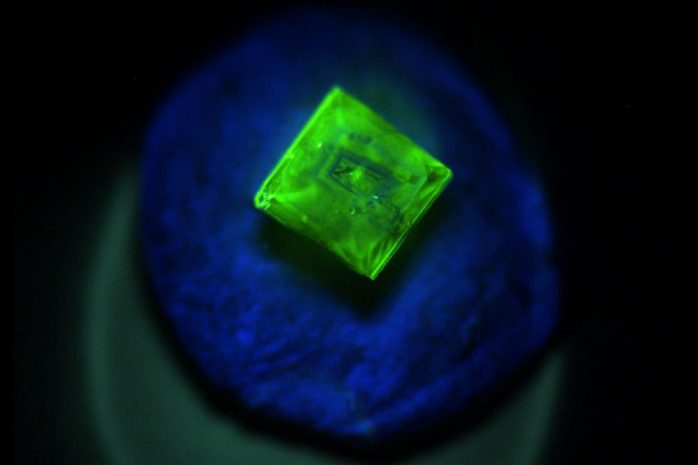Investing In Research
GSI established its Research Center in order to remain at the forefront of important developments in the worldwide gem and diamond industries. GSI openly shares research findings with others in the trade. The Research Center works closely with leading manufacturers of high-tech equipment to integrate GSI’s knowledge of gem laboratory requirements with those manufacturers’ expertise in hardware, software, magnification, optics, lighting and other fields. Through its efforts, GSI has pioneered important breakthroughs in identifying manmade and treated diamonds.

Investing In Education
GSI firmly believes that trade and consumer education is critical to the long- term success of the diamond and jewelry industry. It also uses industry connections to promote communication and education programs for both the trade and consumers.
The Knowledge Center offers a variety of educational initiatives for both the trade and general public. In fact, it can be considered a one-stop destination for a gemological education, and a source for numerous educational programs for related industries.
The Knowledge Center’s curriculum focuses on industry-specific technical training at all levels. GSI believes informed and properly trained employees are the key to increasing the quality of services and ultimately helping both individuals and trade entities to realize their full potential.

GSI tests jewelry designs that contain both natural and laboratory-grown diamonds
The photo above is typical of jewelry that GSI tests that contain both natural and laboratory-grown diamonds. The photo is captured by exposing the diamonds to deep short wave ultraviolet radiation (SWUV) at about 225 nm. At this wavelength of light, the growth patterns of the diamond become evident by exciting fluorescence at the surface of the diamond. The pattern is then used to determine if the diamond shows natural or laboratory-grown growth.
Most natural diamonds contain nitrogen aggregates in the form of N3 centers which have a characteristic blue fluorescence in varying concentrations which are observed in the image above. Diamonds with green fluorescence have H3 defects, which can be natural or laboratory-grown, so researchers rely on the growth patterns and other advanced testing methods to make expert assessments about the growth origin of the diamond.
As laboratory-grown diamond growth technology evolves, it becomes increasingly difficult to discern growth origin. Determining natural from laboratory-grown diamonds requires a variety of tests and expert gemologists to interpret results.

This image shows lead-glass filler in ruby
This image shows lead-glass filler in ruby. The image is obtained by exposing the ruby to long-wave ultraviolet light (LWUV). This causes the ruby to fluoresce red, and the lead-glass filler to fluoresce blue and confirms treatment. It is evident the glass has filled fractures and cavities in the ruby. Lead-glass filled ruby is a composition of ruby and lead-based glass.
Rubies are treated with lead-based glass to minimize the appearance of fractures. The glass is used to match the refractive index of the ruby and the path of light passing through the gem is not disturbed and the fracture becomes less visible. The treatment is also intended to increase the durability of lower-quality rubies, improve appearance, and add weight.
Glass-filled rubies require special care, and are susceptible to chemicals and acids, as well as potential damage when exposed to excessively high heat, or wear.

FTIR
Gemological laboratories with advanced instrumentation will often have an analytical instrument known as a spectrophotometer. A visible light spectrophotometer is very similar to a spectroscope, but provides a finer reading and is more sensitive. The best units tend to be dual beam units where the reference beam is used in comparison to the beam that passes through the sample. The record is in the form of an x-y diagram where the x-axis represents the wavelength scale in nanometers/cm-1 and the y-axis represents the absorption or transmission intensity.
Spectrophotometers come in several forms and are tuned to specific wavelengths and one of them is FTIR (Fourier Transform infrared spectrometers). FTIR is used to characterize diamond types and detect HPHT and CVD diamonds, detect the type of filling in emeralds and determine the origin of some gemstones, particularly sapphires. A spectroscope is a powerful tool for identifying gemstones and making various separations of interest to the gemologist. (Pictured is a GSI gemologist placing gemstone in the FTIR chamber)

Immersion Microscope
This strange looking instrument is a horizontal microscope with an immersion cell. Immersion microscopy is a technique where a gem is placed in a container of liquid, thus eliminating surface reflections of all types. Immersion can be carried out in plain or polarized light and with a horizontal immersion microscope. Immersion is effective for observing curved color banding, surface diffusion, plato lines, gem treatment evidence, country of origin inclusion studies, etc.

DiamondView
The image with vivid blue and green colors on the left is a diamond under UV light. A low wavelength luminescence imaging device developed by the DTC (De Beers) with its high energy ultraviolet light source looks at the surface fluorescence by illuminating with short-wave ultra-violet light thus enabling to observe the sometimes-complex growth morphology of diamonds. The color of the fluorescence, the fluorescence pattern and the absence or presence of phosphorescence will differ depending on the stones natural or synthetic origin. (Pictured is a princess cut diamond)


